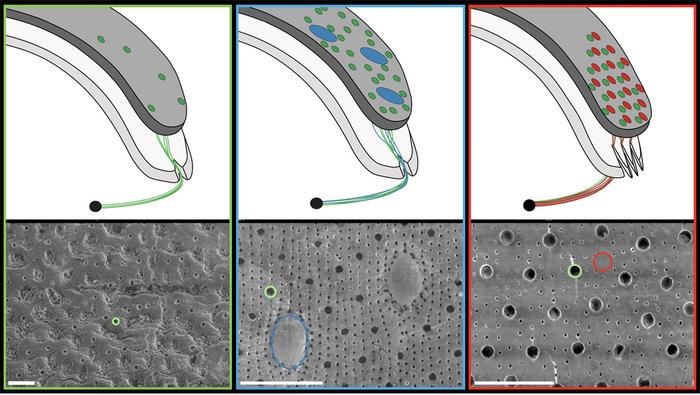With armor-like shells covered in eyes, chitons are truly strange little beasties. Now, researchers have discovered even more weirdness underlying the evolution of their visual systems. Not only do chitons have the most recently evolved eyes with a lens, but their two kinds of eyes arose in four separate events.
Chitons are marine mollusks – and they’re really odd. Ovoid in shape, they crawl slowly over rocks in the intertidal zone, and are recognizable for their coat-of-mail shells that form an armor across their backs. One species, with the unflattering but not unreasonable nickname “wandering meatloaf”, has teeth made of an iron-based mineral previously only seen in rocks. And then there’s the eyes. Chitons’ sensory organs aren’t located on their bodies, but on their shells.
“I don’t think there’s any other animal that builds its eyes into its armor like a chiton does,” co-author Daniel Speiser said in a statement.
The most abundant sensory organs, found in the outermost layer of the shells of all chitons, are called aesthetes. It is thought that aesthetes form the basis of two different visual systems that evolved in some of these curious critters. The first involves larger shell eyes, with lenses formed of the mineral aragonite that focus light, similar to human eyes. The second is smaller, but more numerous “eyespots” that function like individual pixels, akin to some insects’ compound eyes.
But how did these peculiar peepers evolve? That’s what the team behind the new study wanted to find out. “Is there something that we can identify that is guiding evolution in these different groups toward eyespots or toward shell eyes?” lead author Rebecca Varney asked.

Aesthetes (green) are found on all chitons, while shell eyes (blue) and eyespots (red) only evolved in a few groups. These structures are connected to the chiton’s nervous system via notches in the shell.
To investigate, Varney and co-authors constructed a chiton family tree, finding, to their surprise, that chitons’ ancestors evolved eyes on four different occasions.
“We went in knowing there were two types of eyes, so we were not expecting four independent origins,” Varney said. “The fact that chitons evolved eyes four times, in two different ways, is pretty amazing to me.”
Even weirder, the groups that arrived at similar structures weren’t the ones most closely related to each other. “It almost seemed too strange to be true,” remarked senior author Todd Oakley.
The team discovered that shell eyes in some species of chiton evolved between 250 and 200 million years ago, while in other species they arose during the Cretaceous, some 150 to 100 million years ago, making them the most recent lensed eye. Eyespots, on the other hand, evolved in one group of chitons as early as 260 to 200 million years ago, and as late as 75 to 25 million years ago in another.
Evolution is quite adept at coming up with the same or similar solutions to life’s problems – crabs have evolved at least five times, for example. To find out how this came to be the case for chitons, the team searched for tell-tale differences between species.
They noticed that chitons with eyespots tended to have more slits on the margin of each shell segment, whereas those with shell eyes had far fewer. These slits facilitate nerves that pass from the chiton’s shell into its body. The researchers, therefore, believe that the number of slits present when chitons’ visual systems developed predicts what type of visual system evolved.
“Here we have a very clear demonstration in a natural system that evolution depends on what came before, even when what came before might seem completely unrelated,” Oakley said.
Quite how much chitons can “see” using these two visual systems is still something of a mystery, but is the focus of ongoing research. What we do know, however, is that the evolution of chiton vision is just as bizarre as they are.
The study is published in Science.
Source Link: Bizarre Sea Beasties Covered In Eyes Evolved Their Peepers Four Different Times